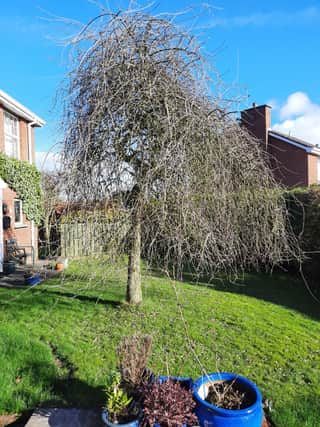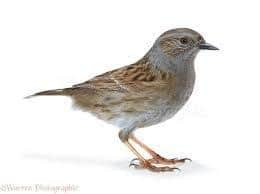Each tree is a nature reserve in miniature - pick a favourite


It’s my fault, because I felled a tree next to it, leaving my tree with no branches or leaves on one side. So it’s not its beauty that has wheedled its way into my affections.
Its position in the garden, (my fault for plonking it there in the first place), means that it blocks out most of the best sun bathing spots.
Advertisement
Hide AdAdvertisement
Hide AdNot only is it in the wrong place, it is from the wrong country. In these environmentally correct times, the preference is for native species.


God forbid - it’s a Japanese pear! Readers will be aware of ‘invasive species’ plants and animals introduced here which are doing untold damage to our native wildlife. Japanese knotweed is among the worst.
Like many invasive species, it dominates our native plants reducing our native biodiversity. This is because it lacks the controls that it experiences in its native environment.
Spring providing a sign of hope in these most difficult of timesIt is particularly loathed because it can cause untold damage to buildings. Its roots can even dig through concrete. Worse still it is very difficult to eradicate. Its natural habitat is the sides of recently erupted volcanoes, like Mount Fuji. What’s a dose of weedkiller compared to barely cooled lava?
Advertisement
Hide AdAdvertisement
Hide AdIn contrast my Japanese alien tree seems to do no damage and has integrated perfectly into the local environment. At the time of writing in early spring, my tree is just beginning to show its buds.
Later it will have its full set of leaves. The leaves will happily perform the photosynthetic miracle throughout the summer.
It will combine water, minerals from the soil, carbon from the air and absorb the energy of the sun to produce the food necessary for its growth and survival.
Photosynthesis provides us with all our food. In addition the tree absorbs the greenhouse gas carbon dioxide and pumps out oxygen reducing global warming and allowing us to breath.
Advertisement
Hide AdAdvertisement
Hide AdIn late spring some of the leaves will transform into delicate white flowers. One of the big puzzles in evolutionary science is the question of what came first, the flowering plants or the insects that pollinate them.
Whatever the answer, it is a joy to hear the bees and other insects visiting the tree to harvest the nectar and pollen.
The insects pollinate the flowers enabling the growth of tiny inedible pears in the autumn. More of them later. Looking out in the morning, what strikes me is that the birds are blissfully unaware of this alien monster in their midst.
It’s a Noah’s ark of the avian world. Over time I have seen numerous species in its branches: house sparrows, hedge sparrows, blue tits, coal tits, great tits, wrens, gold crests, magpies, wood pigeons, starlings, blackbirds and robins etc. There is even the occasional marauding sparrow hawk.
Advertisement
Hide AdAdvertisement
Hide AdAll these birds are worthy of attention but I will make special mention of just two. The hedge sparrow, or dunnock, at least visually, is Ireland’s least attractive bird and is a possible European contender.
Marooned in Derry COVID-19 land and missing Donegal but finding solace in the natural worldIt is about the same size as a robin but lacks its red breast. In fact it lacks any special features, being dull brown all over.
With a surprisingly sweet song, a hedge sparrow has advertised its presence over the last few days from the top branch of the tree.
This is the male bird whose vocal virtuosity declares himself as a suitable mate for any female.
Advertisement
Hide AdAdvertisement
Hide AdI have chosen the word ‘any’ with care. Recent research has proved that monogamy is not on the hedge sparrow’s agenda. Male sparrows will mate with as many as twelve partners in their range.
The females are only marginally better behaved. The contrast with the blue tits could not be greater. They are beautiful little birds with a dark blue head, bluey green back feathers and yellow breasts.
Their family life would meet the approval of any parish priest. They often rear as many as twelve chicks. Timing is everything for these birds.
They must synchronise their breeding to coincide with precise conditions.
Advertisement
Hide AdAdvertisement
Hide AdThe leaves need to be on the trees. Bugs like aphids and caterpillars need to be gnawing on the leaves but this can only occur before the leaves protect themselves with increased tannin to prevent the insects from destroying the leaves altogether.
The blue tits need to build a nest, lay eggs, incubate the eggs and feed their huge brood. The chicks increase their size fourfold on a diet of a thousand bugs each, fed to them by their parents over three weeks.
The whole marathon breeding process takes about seven weeks, ending around mid-May. The nest box nailed to the tree allows me to observe each stage of this annual family drama.
Where have all the flowers gone? Who killed Cock Robin? Where’s Dopey Dick?Things go quiet in the summer months as the tree builds up reserves to face the winter. In autumn the tree prepares by withdrawing its sap into its roots. At the same time the pears reach their pathetic maximum.
Advertisement
Hide AdAdvertisement
Hide AdThey are about the size of grapes. Totally inedible to humans but the blackbirds gobble them up. This is nature working in harmony just like the bees and the flowers.
The blackbirds are getting food but they do the essential task of dispersing the seeds. This allows new trees to grow in places away from the parent tree.
In this new location they can flourish with the air, sunlight, soil, water and space they need.
My tree may not be the best species environmentally or the prettiest but it is of great interest all year round. The pandemic grinds on with its boredom, distress to all of us.
Advertisement
Hide AdAdvertisement
Hide AdEarly spring is the ideal time to follow the seasonal changes in our favourite trees.
It is a great way to keep our minds alert to nature. Each tree is a nature reserve in miniature,
It is the home to numerous forms of life displaying many of the connections between them.
It can be a relief from the anxieties and restrictions we face on a daily basis. If you do not already have a favourite tree, look around your surroundings and choose one.